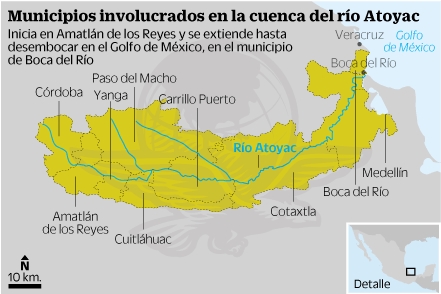The River Atoyac, a river more than 120 kilometers (75 miles) long, in the state of Veracruz, has suddenly dried up. The dramatic disappearance of the river is believed to be due to the collapse of the roof of a cavern in the underlying limestone. This caused the formation of a narrow sinkhole, 30 meters (100 feet) long, that now swallows the river and diverts its water underground.
The collapse happened on Sunday 28 February; residents of the small ranch town of San Fermín heard a thunderous noise at the time. Within 48 hours, the river had disappeared.
The River Atoyac rises on the slopes of the Pico de Orizaba, Mexico’s highest peak. Unfortunately, the cavern collapse occurred only 3 kilometers from the river’s source, leaving almost all of its course dry, with potentially serious consequences for up to 10,000 people living in the river basin who have now lost their usual water supply.
The disappearance of the river will also have adverse impacts on fauna and flora, and jeopardize sugar-cane farming and other activities downstream. The fauna of the river included fresh-water crayfish (langostinos) which were an important local food source.
The municipalities affected are Amatlán de los Reyes, Atoyac, Yanga, Cuitláhuac, Felipe Carrillo Puerto, Cotaxtla, Medellìn and Boca del Río.
The course of the river approximately follows that of federal highway 150D, the main toll highway between the cities of Orizaba and Veracruz.
Related posts
- The geography of Mexico’s caves
- Deepest water-filled sinkhole in the world: El Zacatón, Tamaulipas
- Mexico’s geomorphosites: El Sótano de las Golondrinas (Cave of the Swallows)
- Geotourism in Mexico: García Caves (Grutas de García) in Nuevo León
- World’s longest underground river flows deep beneath the Yucatán Peninsula
3 Responses to “The sudden disappearance of the Rio Atoyac in Veracruz”
Sorry, the comment form is closed at this time.

Love this information — reading the body of Mexico.
This is a shocking disaster for the people living close by.
When the longer-term impacts and responses become clearer, we’ll try to provide an update on this situation. Right now, “authorities” are reported to be trucking in water and examining alternatives, which included at one point the idea of trying to “fill the hole in” in order to reestablish the river course. Geologists have, not surprisingly, nixed that idea.